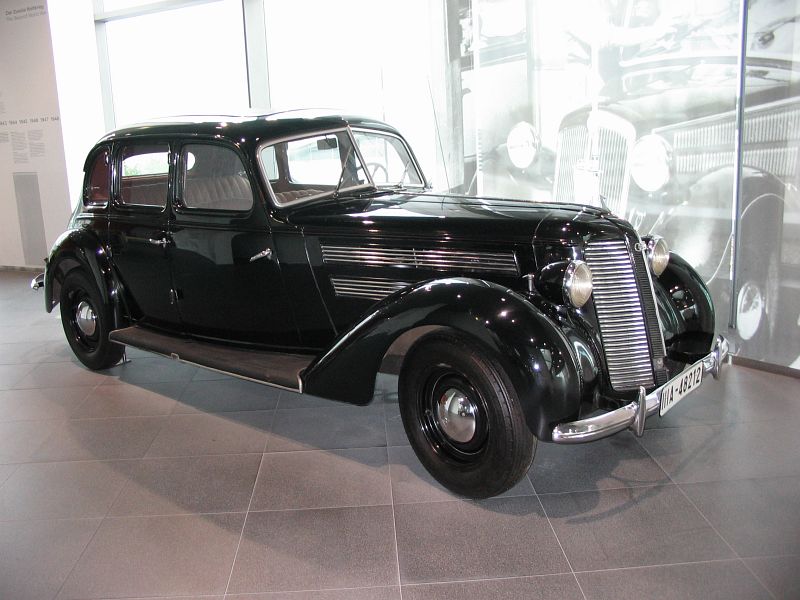The dawn of modern automotive luxury emerged from an unexpected time — the late 1930s. As Europe stood on the precipice of profound change, Audi unveiled a masterpiece that would reshape the future of German engineering. The Audi 920, introduced at the 1939 Berlin Motor Show, represented more than just another luxury car; it embodied the culmination of pre-war automotive innovation.
This remarkable vehicle emerged during a pivotal moment in automotive history. While most manufacturers focused on utility, Audi dared to dream bigger. The 920 combined raw power with unprecedented refinement, setting new standards for what a luxury automobile could achieve. Its development under the umbrella of Auto Union showcased the innovative spirit that would later define the four rings brand.
Engineering Excellence Unleashed
The heart of the Audi 920 beat with remarkable precision. Its 3281cc inline-six engine delivered 75 horsepower at 3000 RPM — modest by today’s standards but revolutionary for its era. The overhead valve design brought new levels of efficiency and reliability to the luxury segment.
Historical Reference!
The engine's development team worked closely with racing divisions, incorporating lessons learned from Auto Union's grand prix experiences. This cross-pollination of ideas resulted in an engine that was both powerful and remarkably refined for its time.
Dr. Heinrich Mueller, a period automotive engineer, noted in his technical review: «The 920’s powerplant represents the perfect marriage of performance and sophistication. Its smooth power delivery and exceptional reliability set new benchmarks for luxury automobiles of the era.»
The four-speed manual transmission translated this power into smooth, confident progress. With a top speed of 130 km/h, the 920 proved itself capable of sustained high-speed cruising on Germany’s expanding network of autobahns. The drivetrain’s robustness ensured that this performance remained consistent throughout the vehicle’s life.
Design and Dimensions: A Study in Elegance
The 920’s physical presence commanded attention through sophistication rather than ostentation. Its 122-inch wheelbase provided both impressive road presence and exceptional interior space. The design team achieved a perfect balance between authority and elegance.
Key dimensional attributes that defined the 920’s presence:
- wheelbase length of 310 cm ensuring stable handling;
- overall length of 490 cm providing generous interior space;
- height of 162 cm striking the perfect balance between presence and proportion;
- curb weight of 1670 kg delivering solid road handling.
Fact!
The 920's distinctive radiator grille design influenced Audi styling for decades to come. Its horizontal elements and precise proportions established a design language that would evolve into the modern Audi signature grille.
The availability of both sedan and cabriolet body styles demonstrated Audi’s commitment to serving diverse luxury market segments. The four-door sedan prioritized executive transport, while the two-door cabriolet catered to more lifestyle-oriented buyers.
Historical Context and Legacy
The 920’s production in Zwickau’s Horch facilities added another layer to its fascinating story. Under the Auto Union banner, the boundaries between Horch and Audi began to blur, resulting in a vehicle that combined the best attributes of both brands.
Marcus Reinhardt, a respected classic car restorer, shares: «Each 920 I’ve worked on reveals new details about the extraordinary level of craftsmanship that went into these cars. The build quality rivals anything produced in the era, including the most prestigious luxury manufacturers.»
The model’s influence extended far beyond Germany’s borders. Several examples found homes in Sweden and other European countries, proving its appeal transcended national preferences. This international presence helped establish Audi’s reputation for building world-class luxury automobiles.
The 920’s production run, though brief, left an indelible mark on automotive history. Its combination of advanced engineering and luxury set standards that would influence post-war automotive development across Europe.
The Modern Perspective
Looking at the 920 through a contemporary lens reveals just how forward-thinking its design truly was. Features we now take for granted — such as the advanced ignition system and sophisticated suspension geometry — first appeared in vehicles like the 920.
Key innovations that showcased the 920’s advanced engineering:
- six-cylinder OHV engine with advanced valve timing;
- eight-cylinder ignition system for improved reliability;
- advanced suspension design for superior handling;
- integrated chassis design for improved rigidity;
- aerodynamic considerations in body design.
The few surviving examples today command respect not just for their rarity but for their remarkable engineering. Each restored 920 serves as a rolling testament to the capabilities of pre-war German automotive engineering.
Beyond the Horizon: A Legacy Renewed
The true measure of the Audi 920’s significance lies not just in its specifications or sales figures but in its role as a catalyst for change. It marked the beginning of Audi’s modern era, establishing principles that would guide the brand for decades to come.
In many ways, the 920 predicted the future of luxury motoring. Its emphasis on engineering excellence, comfort, and understated elegance created a template that still influences luxury car design today. The model’s brief but brilliant presence in automotive history demonstrates how innovation can transcend its era.
| Pros | Cons |
|---|---|
| Advanced six-cylinder engine with sophisticated valve design | Limited production run affecting parts availability |
| Exceptional build quality from Horch facilities | High maintenance requirements by modern standards |
| Progressive engineering solutions ahead of its time | Relatively modest power output by contemporary standards |
| Elegant design that influenced future Audi models | Complex ignition system requiring specialist knowledge |
| Available in both sedan and cabriolet variants | Weight impact on performance and handling |
| Superior materials and craftsmanship | Limited surviving examples making restoration challenging |
| Historical significance as a pre-war luxury pioneer | Period-specific features requiring specialized maintenance |
The Audi 920 stands as a testament to the enduring power of visionary engineering. While its production run may have been cut short by historical circumstances, its influence resonates through automotive history. Modern luxury cars may surpass it in power and technology, but few can match its significance as a pioneer of automotive excellence. Its legacy lives on not just in museums and private collections, but in the DNA of every Audi that follows its groundbreaking path.

